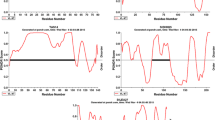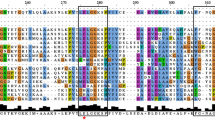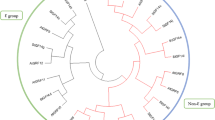Abstract
Late embryogenesis abundant (LEA) proteins were first described as accumulating late in plant seed development. They were also shown to be involved in plant responses to environmental stress and as well as in bacteria, yeast and invertebrates. They are known to play crucial roles in dehydration tolerance. This study describes a genome-wide analysis of LEA proteins and the corresponding genes in Solanum tuberosum. Twenty-nine LEA family members encoding genes in the Solanum genome were identified. Phylogenetic analyses allowed the classification of the potato LEA proteins into nine distinct groups. Some of them were identified as putative orthologs of Arabidopsis and rice LEA genes. In silico analyses confirmed the hydrophilicity of most of the StLEA proteins, whereas some of them can be folded. The in silico expression analyses showed that the identified genes displayed tissue-specific, stress and hormone-responsive expression profiles. Five StLEA classified as dehydrins were selected for expression analyses under salt and drought stresses. The data revealed that they were induced by both stresses. The analyses indicate that several factors such us developmental stages, hormones, and dehydration, can regulate the expression and activities of LEA protein. This report can be helpful for the further functional diversity studies and analyses of LEA proteins in potato. These genes can be overexpressed to improve potato abiotic stress response.







Similar content being viewed by others
References
Shih MD, Hsieh TY, Lin TP, Hsing YC, Hoekstra FA (2010) Characterization of two soybeans (Glycine max L.) LEA IV proteins by circular dichroism and fourier transform infrared spectrometry. Plant Cell Physiol 51:395–407
Du D, Zhang Q, Cheng T, Pan H, Yang W, Sun L (2012) Genome-wide identification and analysis of late embryogenesis abundant (LEA) genes in Prunus mume. Mol Biol Rep. doi:10.1007/s11033-012-2250-3
Lan T, Gao J, Zeng QY (2013) Genome-wide analysis of the LEA (late embryogenesis abundant) protein gene family in Populus trichocarpa. Tree Genet Genomes 9:253–264
Dure L (1993) Structural motifs in LEA proteins. In: Close TJ, Bray EA (eds) Plant responses to cellular dehydration during environmental stress. American Society of Plant Physiologists, Rockville, pp 91–103
Hanin M, Brini F, Ebel C, Toda Y, Takeda S, Masmoudi K (2011) Plant dehydrins and stress tolerance. Plant signal behav 6:1503–1509
Brini F, Hanin M, Lumbreras V, Irar S, Pagès M, Masmoudi K (2007) Functional characterization of DHN5, a dehydrin showing a differential phosphorylation pattern in two Tunisian durum wheat (Triticum durum Desf.) varieties with marked differences in salt and drought tolerance. Plant Sci 172:20–28
Finkelstein RR, Rock C (2002) Abscisic acid biosynthesis and response. In: Meyerowitz EM, Somerville CR (eds) The Arabidopsis book http://www.aspb.org/publications/arabidopsis
Bies-Ethève N, Gaubier-Comella P, Debures A, Lasserre E, Jobet E, Raynal M, Cooke R, Delseny M (2008) Inventory, evolution and expression profiling diversity of the LEA (late embryogenesis abundant) protein gene family in Arabidopsis thaliana. Plant Mol Biol 67:107–124
Filiz E, Ozyigit II, Tombuloglu H, Koc I (2013) In silico comparative analysis of LEA (Late embryogenesis abundant) proteins in Brachypodium distachyon L. Plant Omics 6:433–440
Close TJ (1997) Dehydrins: a commonality in the response of plants to dehydration and low temperature. Physiol Plant 100:291–296
Battista JR, Park MJ, McLemore AE (2001) Inactivation of two homologues of proteins presumed to be involved in the desiccation tolerance of plants sensitizes Deinococcus radiodurans R1 to desiccation. Cryobiology 43:133–139
Goyal K, Pinelli C, Maslen SL, Rastogi RK, Stephens E, Tunnacliffe A (2005) Dehydration-regulated processing of late embryogenesis abundant protein in a desiccation-tolerant nematode. FEBS Lett 579:4093–4098
Close TJ (1996) Dehydrins: emergence of a biochemical role of a family of plant dehydration proteins. Physiol Plant 97:795–803
Reyes JL, Rodrigo MJ, Colmenero-Flores JM, Gil JV, Garay-Arroyo A, Campos F, Salamini F, Bartels D, Covarrubias AA (2005) Hydrophilins from distant organisms can protect enzymatic activities from water limitation effects in vitro. Plant, Cell Environ 28:709–718
Irar SEO, Pagès M, Goday A (2006) Towards the identification of late-embryogenic-abundant phosphoproteome in Arabidopsis by 2-DE and MS. Proteomics 6:175–185
Bray EA (1993) Molecular responses to water deficit. Plant Physiol 103:1035–1040
Tunnacliffe A, Wise M (2007) The continuing conundrum of the LEA proteins. Naturwissenschaften. doi:10.1007/s00114-007-0254-y
Wise MJ (2003) LEAping to conclusions: a computational reanalysis of late embryogenesis abundant proteins and their possible roles. BMC Bioinformatics 4:52
Hundertmark M, Hincha DK (2008) LEA (Late embryogenesis abundant) proteins and their encoding genes in Arabidopsis thaliana. BMC Genomics 9:118. doi:10.1186/1471-2164-9-118
Espelund M, Saeboe-Larssen S, Hughes DW, Galau GA, Larsen F, Jakobsen KS (1992) Late embryogenesis-abundant genes encoding proteins with different numbers of hydrophilic repeats are regulated differentially by abscisic acid and osmotic stress. Plant J2:241–252
Arumingtyas EL, Savitri ES, Purwoningrahayu RD (2013) Protein profiles and dehydrin accumulation in some soybean varieties (Glycine max L. Merr) in drought stress conditions. Am J Plant Sci 4:134–141
Wang Y, Xu H, Zhu H, Tao Y, Zhang G, Zhang L, Zhang C, Zhang Z, Ma Z (2014) Classification and expression diversification of wheat dehydrin genes. Plant Sci 214:113–120
Xu H, Yang Y, Xie L, Li X, Feng C, Chen J, Xu C (2014) Involvement of multiple types of dehydrins in the freezing response in loquat (Eriobotrya japonica). PLoS One. doi:10.1371/journal.pone.0087575
Yang Y, He M, Zhu Z, Li S, Xu Y, Zhang C, Singer SD, Wang Y (2012) Identification of the dehydrin gene family from grapevine species and analysis of their responsiveness to various forms of abiotic and biotic stress. BMC Plant Biol 12:140
Garay-Arroyo A, Colmenero-Flores JM, Garciarrubio A, Covarrubias AA (2000) Highly hydrophilic proteins in prokaryotes and eukaryotes are common during conditions of water deficit. J Biol Chem 275:5668–5674
Galau GA, Wang HYC, Hughes DW (1993) Cotton Lea5 and Lea14 encode atypical late embryogenesis-abundant proteins. Plant Physiol 101:695–696
Higgins D, Thompson J, Gibson T (1994) CLUSTAL W: improving the sensitivity of progressive multiple sequence alignment through sequence weighting, position-specific gap penalties and weight matrix choice. Nucleic Acids Res 22:4673–4680. doi:10.1093/nar/22.22.4673
Tamura K, Peterson D, Peterson N, Stecher G, Nei M, Kumar S (2011) MEGA5: molecular evolutionary genetics analysis using maximum likelihood, evolutionary distance and maximum parsimony methods. Mol Biol Evol 28:2731e9
Voorrips RE (2002) MapChart: software for the graphical presentation of linkage maps and QTLs. J Hered 93:77–78
Li WH (1993) Unbiased estimation of the rates of synonymous and non synonymous substitution. J Mol Evol 36:96–99
Pamilo P, Bianchi NO (1993) Evolution of the Zfx and Zfy genes: rates and interdependence between the genes. Mol Biol Evol 10:271–281
Xu X, Pan S, Cheng S (2011) Genome sequence and analysis of the tuber crop potato. Nature 475:189–195
Saeed AI, Sharov V, White J, Li J, Liang W, Bhagabati N, Braisted J, Klapa M, Currier T, Thiagarajan M et al (2003) TM4: a free, open-source system for microarray data management and analysis. Biotechniques 34:374–378
Murachige T, skoog F (1962) A revised medium for rapid growth and bioassays with tobacco tissue cultures. Physiol Plant 15:473–497
Morel G, Wetmore RH (1951) Fern callus tissue culture. Am J Bot 38:141–143
Vaewoerd TC, Dekker BMM, Hoekema A (1989) A small scale procedure for the rapid isolation of plant RNAs. Nucleic Acid Res 17:23–62
Saidi MN, Gargouri-Bouzid R, Rayanni M, Drira N (2009) Optimization of RNA isolation from brittle leaf disease affected date palm leaves and construction of a subtractive cDNA library. Mol Biotechnol 41:63–68
Degenhardt J, Al-MasriA N, Kurkcuoglu S, Szankowski I, Gau AE (2005) Characterization by suppression subtractive hybridization of transcripts that are differentially expressed in leaves of apple scab-resistant and susceptible cultivars of Malus domestica. Mol Genet Genomics 273:326–335
Wang XS, Zhu HB, Jin GL, Liu HL, Wu WR, Zhu J (2007) Genome-scale identification and analysis of LEA genes in rice (Oryza sativa L.). Plant Sci 172:414–420
Campbell SA, Close TJ (1997) Dehydrins: genes, proteins, and associations with phenotypic traits. New Phytol 137:61–74
Alsheikh MK, Svensson JT, Randall SK (2005) Phosphorylation regulated ion-binding is a property shared by the acidic subclass dehydrins. Plant, Cell Environ 28:1114–1122
Prilusky J, Felder CE, Zeev-Ben-Mordehai T, Rydberg E, Man O, Beckmann JS, Silman I, Sussman JL (2005) FoldIndex©: a simple tool to predict whether a given protein sequence is intrinsically unfolded. Bioinformatics 21:3435–3438
Krogh A, Larsson B, Von Heijne G, Sonnhammer ELL (2001) Predicting transmembrane protein topology with a hidden Markov model: application to complete genomes. J Mol Biol 305:567–580
Hanada K, Zou C, Lehti-Shiu MD, Shinozaki K, Shiu SH (2008) Importance of lineage specific expansion of plant tandem duplicates in the adaptive response to environmental stimuli. Plant Physiol 148:993–1003
Massa AN, Childs KL, Lin H, Bryan GJ, Giuliano G, Buell CR (2011) The transcriptome of the reference potato genome Solanum tuberosum Group Phureja clone DM1-3 516R44. PLoS ONE. doi:10.1371/journal.pone.002680
Acknowledgments
This work was financed by the Tunisian Ministry of High Education and Scientific Research. The authors are grateful to Anne-Lise Haenni from the Institute Jacques Monod (France) for reading and improving the English.
Author information
Authors and Affiliations
Corresponding author
Electronic supplementary material
Below is the link to the electronic supplementary material.
Rights and permissions
About this article
Cite this article
Charfeddine, S., Saïdi, M.N., Charfeddine, M. et al. Genome-wide identification and expression profiling of the late embryogenesis abundant genes in potato with emphasis on dehydrins. Mol Biol Rep 42, 1163–1174 (2015). https://doi.org/10.1007/s11033-015-3853-2
Received:
Accepted:
Published:
Issue Date:
DOI: https://doi.org/10.1007/s11033-015-3853-2




